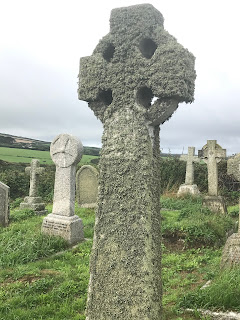This village developed around the medieval harbour.
In the 12th century the Botterell family built Bottreaux Castle and a settlement developed alongside. The name of Boscastle is derived from a corruption of Bo' Castle. According to our welcome folder, Bronze Age barrows and an Iron Age promontory fort nearby provide evidence of man's activities in earlier times.
Much of the land and many of the buildings around Boscastle are owned or managed by the National Trust. Some were purchased by the Trust, other donated by their owners—often as part of someone's will. The Gaffer and 2 other cottages, the Clinker and the Lugger, are located in a building that was once the Harbor Restaurant.
The building now includes the 3 holiday cottages and the National Trust Bookstore and area visitor center. We are within just a short walk of the natural harbor that provided the only refuge along this section of the Cornish coast from a boisterous sea. Fishing boats are anchored there today.
The National Trust pathways around the harbor and down the Valency Valley have provided great places for us to walk each day, even when it was rainy and windy. The Brits are tough people who expect the weather we are seeing here. Last weekend was the August Bank Holiday, a 3-day weekend on the 4th Monday of August (close to the Labor Day Weekend in the States—a last holiday weekend to end the summer tourist season) just before local schools resume classes for the winter.
This is the harbor lookout, still staffed today. Here a boat in distress can be spotted and rescue vessels sent out to help.
So far, we have enjoyed such spectacular views of the coast and the green hills and ancient villages on this trip. Tuesday we drove 4 miles to the next seaside village, Tintagel, to explore the Tintagel Post Office, a 6th century building that has been used in many different ways over the centuries, from great hall to family home to post office.
The garden behind the old post office is very nice.
Today it is one of the historical properties cared for by the National Trust. We also walked around the ruins of a 13th century castle built by a prominent nobleman on the reported place where King Arthur once lived. We had been seeing references to Arthur throughout the area and his memory is memorialized everywhere in Tintagel. We never saw any evidence of his knights or the round table, but children can buy knight's helmets and Excalibur swords. There is evidence of occupation of the headland, where the castle ruins are found, since the 600s.
Getting to the castle involves going up and down a whole lot of steps. I guess it would have given the early castle-dwellers time to prepare their defenses.
Both Tintagel and Boscastle are impressively full of tourists. If you know Colorado, think of the summer crowds in Estes Park or Grand Lake. Parking is difficult to find and you have to use the sidewalks with care because of the crowds.
At Boscastle we have walked all over the area, including to 2 small churches hidden in the woods but still with small congregations.
First we hiked to the Minster church.
Another day we checked out the Forrabury Church.
You can see how moss has grown on these old gravestones.
While hiking we also saw stunning harbor views, woodland trails and views of the Forrabury Stitches. The what? You read it correctly. They are strip fields, a rare survivor of the stitchmeal system once widespread in the county. The open fields of the stitches were farmed under common ownership until at least the 17th century. By 1844 they were held by 14 separate owners. Over the last few centuries there was a flurry of enclosing agricultural land with hedges and walls, as we have seen during our travels in England. The open field farming of the stitches is quite different. Between 1955 and 2000 the National Trust received ownership of the stitches. Wednesday we walked across one of them.
We found some interesting stiles to get from one field to another.
Sent from my iPad





























No comments:
Post a Comment